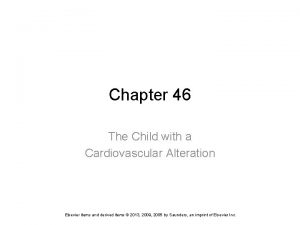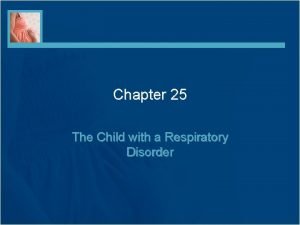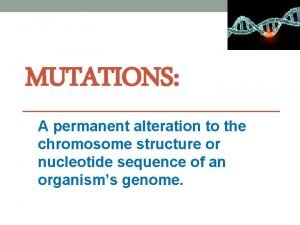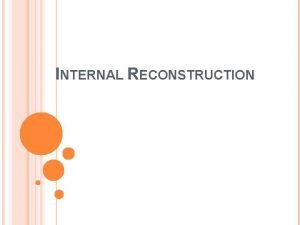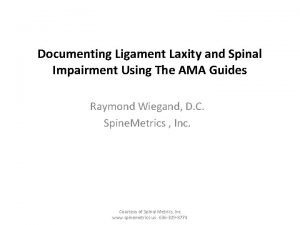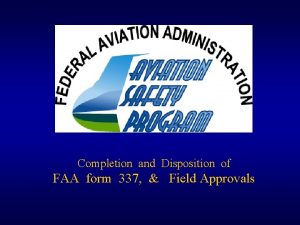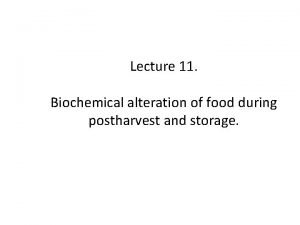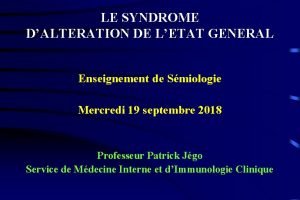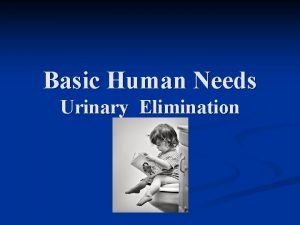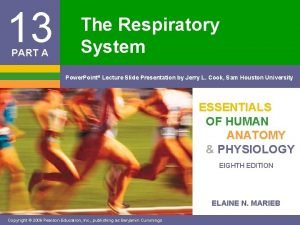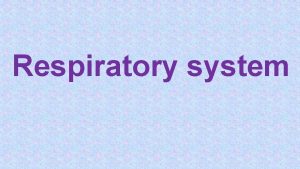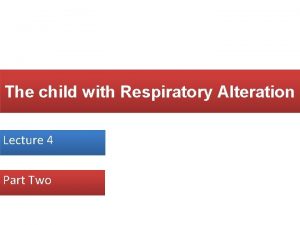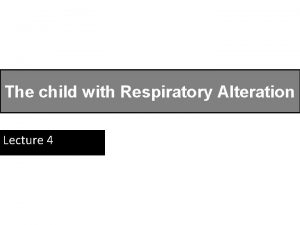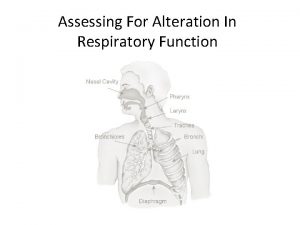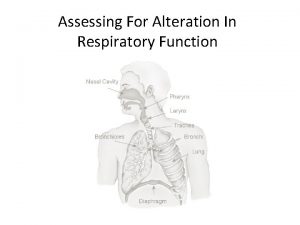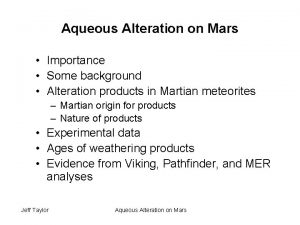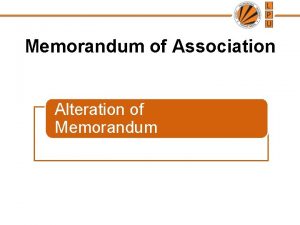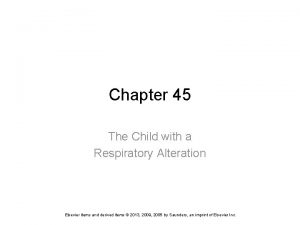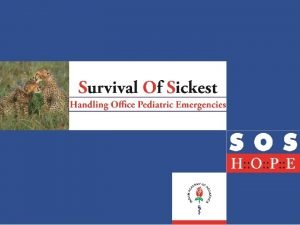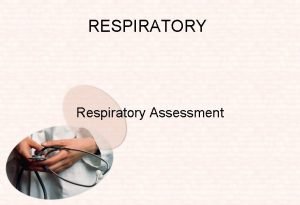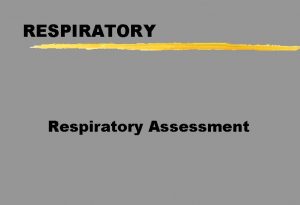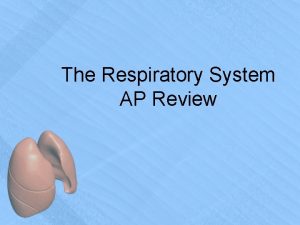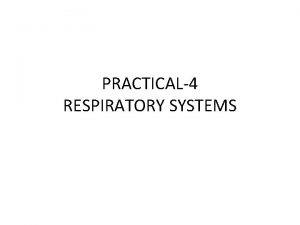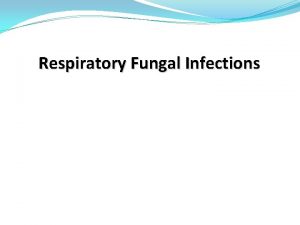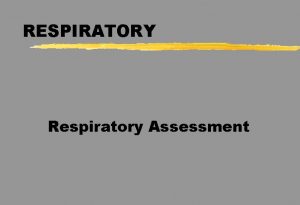The child with respiratory Alteration Lecture 3 Part








































- Slides: 40

The child with respiratory Alteration Lecture 3, Part one

Anatomy of the Respiratory System 04/12/2020 2

Anatomy of the Respiratory System (cont. ) What is respiration? • Respiration is the act of breathing: • inhaling (inspiration) - taking in oxygen. • exhaling (expiration) - giving off carbon dioxide. What makes up the respiratory system? • The respiratory system is made up of the organs involved in the interchanges of gases, and consists of the: - nose - pharynx - larynx - trachea - bronchi - lungs 04/12/2020 3

Anatomy of the Respiratory System (cont. ) The upper respiratory tract includes the following: nose nasal cavity Sinuses: ethmoid, frontal, maxillary, sphenoid larynx trachea The lower respiratory tract includes the following: lungs airways (bronchi and bronchioles) air sacs (alveoli) 04/12/2020 4

Variations in Pediatric Anatomy and Physiology Ø Nose • Newborns are obligatory nose breathers until at least 4 weeks of age. Ø Throat • The tongue of the infant relative to the oropharynx is larger than in adults. Ø Trachea • The airway lumen is smaller in infants and children than in adults. The infant’s trachea is approximately 4 mm wide compared with the adult width of 20 mm. 04/12/2020 5

Variations in Pediatric Anatomy and Physiology • Fewer alveoli – Constantly Growing – Alveoli Increase in Number & Size Until 12 yr – Primarily diaphragmatic breathers until ~ 6 yr • Increased chest compliance: poor expansion & decreased lung volume • The bifurcation of the trachea occurs at the level of the third thoracic vertebra in children, compared to the level of the sixth thoracic vertebra in adults 04/12/2020 6

Variations in Pediatric Anatomy and Physiology • infants are born with about 50 million alveoli. After birth, alveolar growth slows until 3 months of age and then progresses until the child reaches 7 or 8 years of age, at which time the alveoli reach the adult number of around 300 million. place the child at a higher risk of hypoxemia

04/12/2020 8

ASSESSMENT • Observation – Level of Consciousness, Activity; Awareness – Skin Color: Pink, Pale. – Cough : dry, wet, forceful or week Child with Mild Cyanosis 04/12/2020 9

ASSESSMENT • Observation (cont. ) – Respiratory Rate & Work of Breathing • Grunting: Audible at End of Expiration; Attempt to Keep Airway Open • http: //www. youtube. com/watch? v=Xgd. GRP-x. Vf. M • Stridor: High-pitched sound produced by an obstruction of the trachea or larynx that can be heard at inspiration or expiration. • Nasal Flaring: Nostrils Flare in Attempt to Increase Airway Diameter • Retractions: Chest Wall is Drawn Inward During Inspiration Due to Flexible (Cartilage) Airway 04/12/2020 10

04/12/2020 11

Location of Retractions 04/12/2020 12

ASSESSMENT • Auscultation – CRACKLES: Coarse or Fine; Related to Fluid in Airway (Pneumonia, CHF) – WHEEZES: Musical Sound Related to Turbulent Airflow in Constricted Airway (Asthma) • DESCRIBE Location of Retractions & Adventitious Airway Sounds; Use LANDMARKS 04/12/2020 13

UPPER RESPIRATORY TRACT INFECTION 04/12/2020 14

Nasopharyngitis Ø Nasopharyngitis: Common cold. Ø Causes: rhinovirus, adenovirus, influenza virus, Resp. syncytial virus (RSV), Para influenza virus. Ø Clinical manifestations: fever, irritability, restlessness, sneezing, vomiting, diarrhea. dryness, irritation of nose, & Throat, cough, sneezing , chilly sensation, muscular aches. Physical signs: edema& vasodilatation of mucosa. 04/12/2020 15

Nasopharyngitis

Nasopharyngitis (cont. ) q Therapeutic management: § Mostly treated at home , no vaccine, antipyretics for fever. § Decongestants: nose drops more effective than orally. § Cough: suppressant. § Antihistamine are ineffective. § Antibiotic: usually not indication. Nursing consideration: • For nasal obstruction: elevate head of bed, suctioning and vaporization, saline nasal drops. • Maintain adequate fluid intake to prevent dehydration. • Avoiding spread the virus. 04/12/2020 17

Pharyngitis • Causes : 80 -90%of cases are viral cause , other is group A and B hemolytic streptococci • Clinical manifestation: - May be mild so no symptoms. - Headache, fever, abdominal pain exudates on pharynx& tonsils, 3 -5 days usually symptoms are subside • Complication if not treated : - Acute glumerulonephritis syndrome in about 10 days. 04/12/2020 18

Pharyngitis (cont. ) • Diagnostic evaluation: throat culture should be performed to rule out. • Therapeutic management: - If streptococcal sore throat infection: oral Penicillin for 10 days , or IM Benzathine penicillin G. - Oral Erythromycin if the child has allergy to penicillin. • Nursing consideration: - Obtain throat swab for culture. - Administer penicillin & analgesic. - Cold or warm compresses to the neck may provide relief. - 04/12/2020 Warm saline gargles. 19

Pharyngitis (cont. ) • Nursing consideration (cont. ) - Soft liquid food are more acceptable than solid. - Continue oral medication to complete the course. - IM injection applied in deep muscle as vastus lateralis or ventrogluteal muscle, use Emla cream before IM around 2 hours. - Nurse role to prevent the spread of disease. - Children are considered non infectious to other 24 hours after initiation of antibiotics therapy. 04/12/2020 20

Tonsillitis • Tonsils are masses of lymphoid tissue, first immune defense. • Tonsillitis often occur with pharyngitis, viral or bacterial causes. • S& S: - enlarge tonsils, difficult breathing & swallow. - Enlargement of adenoid, blocked postnasal space &mouth breathing. 04/12/2020 21

Tonsillitis

Tonsillitis • Therapeutic management: - throat culture to determine the causative agent , viral or bacterial - Tonsillectomy & adenoidectomy (T&S) - Contraindicating for Ts &As: cleft palate, tonsillitis, blood disorder. • Nursing consideration: Ø Providing comfort & maintain minimize activities. Ø A soft or liquid diet is prescribed. Ø Warm salt water gargles Ø Analgesic, antipyretic. 04/12/2020 23

Tonsillitis • Post operative care: Ø Position (place child on abdomen or side). Ø Discourage child from coughing frequency. Ø Some secretion are common as dried blood. Ø Crushed ice& ice water to relief pain. Ø Analgesic may be rectally or IV, avoid oral route. 04/12/2020 24

Tonsillitis • Post operative care (cont. ): Ø Soft food, milk or ice cream Ø Check post operative signs of Hemorrhage: - Increase pulse more than 120 b/min. Pallor. Frequent swallowing. Vomiting of bright blood Decrease blood pressure is late sign of shock. Note: use good light to look direct on site of operation. 04/12/2020 25

Otitis Media: OM • OM is inflammation of middle ear. • Episode of acute OM occur in the first 24 month, decrease at 5 years, r/to drainage through the Eustachian tube & inflammatory of Resp. system. • Etiology: - Acute (AOM): streptococcus, Haemophilus influenza, moraxella catarrhlis, are the most common bacteria. - OM: blocked Eustachian tube from edema of URTI , allergic hypertrophy adenoid. - Chronic (COM): extension of AOM. 04/12/2020 26

Otitis Media: OM (cont. ) • Diagnostic evaluation: assessment of tympanic membrane with otoscope: AOM: purulent discolored effusion, bulging • S&S: otalgia (earache), fever, purulent discharge, infant rolls his head from side to side, loss of appetite, crying or verbalized feeling of discomfort (older child). • COM: hearing loss, feeling of fullness, vertigo, tinnitus. 04/12/2020 27

Otitis Media: OM (cont. ) • - Therapeutic management: Antibiotic for 10 -14 days e. g. Amoxicillin. Myringotomy: surgical incision of eardrum& grommets. Hear test after 3 month of AOM. • Nursing consideration: Ø Relieving pain. analgesic drug +ice bag on ear. Ø Facilitate drainage & topical A. Biotics. Ø Preventing complication. Ø Instruct family to be careful when deal with child. With temporary hearing loss. Ø Preventing OM during infant feeding and setting after that. 28

Otitis Media: OM

Lower Respiratory Tract Infections 04/12/2020 30

Infection of the Lower Air ways • Cartilaginous support of the air ways is not fully developed until adolescence, consequently the smooth muscle in these structures represents a major factor in the constriction of the airway. 04/12/2020 31

Bronchitis • Bronchitis or tracheobronchitis is inflammation of larger air way (trachea and bronchi). • Causative agents: viruses or mycoplasma pneumonia. • Ch-ch & symptoms: dry, nonproductive cough that worsens at night then become productive in 2 -3 days. • Bronchitis is a mild disease required symptomatic treatment as antipyretic, analgesic and humidity, cough suppressants may be useful at night. 04/12/2020 32


Bronchiolitis & Resp. Syncytial Virus RSV • Bronchiolitis: is an acute viral infection with maximum effect at the bronchiolar level, and rare in children older of 2 years. § One of the Most Frequent Cause of Hospitalization in Infants § Virus or Bacteria Causes Inflammatory Response & Obstruction of Small Airways From Edema • RSV is responsible of 80% of cases during epidemic periods. 04/12/2020 34

Pneumonia • Pneumonia: is inflammation of the pulmonary parenchyma. • Common in children but more frequently occur in infancy & early childhood. • Types of pneumonia (depend on place): Ø Lobar- Pneumonia: one-lobe or more (bilateral or double Pneumonia). Ø Broncho Pneumonia: begins in the terminal bronchioles form consolidated patches in nearly lobules, also called lobular Pneumonia. Ø Interstitial Pneumonia: inflammatory process is confined within the alveolar walls and peribronchial and interlobular tissues. 35 04/12/2020

Pneumonia (cont. ) • Morphology classification: viral, bacterial, mycoplasma , aspiration of foreign body, fungal. • Viral Pneumonia: Ø Occurs more than bacterial. Ø Causes: RSV, parainfluenza, adenovirus. Ø Clinical symptoms: fever, cough, abnormal breath sound; whitish sputum, nasal flaring, retraction, chest pain, pallor to cyanosis, irritable, restless, anorexia, vomiting, diarrhea, abdominal pain. 04/12/2020 36

Pneumonia (cont. ) • Viral Pneumonia (cont. ): Ø Treatment: - symptomatic: O 2 therapy, Comfort. - Chest physiotherapy and postural drainage. - Antipyretics, Fluid intake, & Family supports. 04/12/2020 37

Bacterial Pneumonia • Streptococcus Pneumonia is the most common cause in children and adult • In infant mainly followed viral infection. • Symptoms: fever, malaise, rapid& shallow respiration, cough, chest pain, abdominal pain? ? Appendicitis, meningeal symptoms. • Treatment: bed rest, antipyretic, fluid intake, need hospitalization when pleural effusion or empyema, I. V fluid, O 2 therapy. 04/12/2020 38

Bacterial Pneumonia (cont. ) • Complication: - Tension pneumothorax and empyema if the causative agent is staphelococcus auoraus, - lung abscess if pnumococcal pneumonia. • Prognosis: is generally good if recognize the disease early & treat early. • Prevention: pnumococcal poysaetheride vaccine for 04/12/2020 children older than 2 years who is risk. 39

Bacterial Pneumonia (cont. ) • Nursing consideration: Ø Administer of O 2 therapy , rest, humidity. Ø Assess Resp. status frequently. Ø I. V fluid intake. Ø Antipyretic. Ø Lying the child on affected side. Ø Suctioning by bulb syringe for infant. Ø Chest physiotherapy & postural drainage. Ø Family support & reassurance. 04/12/2020 40
 Chapter 46 the child with a cardiovascular alteration
Chapter 46 the child with a cardiovascular alteration Respiratory zone
Respiratory zone 01:640:244 lecture notes - lecture 15: plat, idah, farad
01:640:244 lecture notes - lecture 15: plat, idah, farad Chapter 25 the child with a respiratory disorder
Chapter 25 the child with a respiratory disorder Alterations in various aspects of society over time...
Alterations in various aspects of society over time... A permanent alteration that changes a dna sequence
A permanent alteration that changes a dna sequence Share capital reduction accounting entries
Share capital reduction accounting entries Alteration of motion segment integrity
Alteration of motion segment integrity Major repair and alteration form 337 example
Major repair and alteration form 337 example Feed enzyme
Feed enzyme Alteration or alternation
Alteration or alternation Factors of social change
Factors of social change Kinds of share capital
Kinds of share capital Alteration de l'etat general selon l'oms
Alteration de l'etat general selon l'oms Chemical alteration definition
Chemical alteration definition Alteration in urinary elimination
Alteration in urinary elimination Examples of alteration
Examples of alteration Voice box
Voice box Part of the respiratory system
Part of the respiratory system Part of respiratory system
Part of respiratory system 전위 순회
전위 순회 Hát kết hợp bộ gõ cơ thể
Hát kết hợp bộ gõ cơ thể Frameset trong html5
Frameset trong html5 Bổ thể
Bổ thể Tỉ lệ cơ thể trẻ em
Tỉ lệ cơ thể trẻ em Voi kéo gỗ như thế nào
Voi kéo gỗ như thế nào Thang điểm glasgow
Thang điểm glasgow Chúa yêu trần thế alleluia
Chúa yêu trần thế alleluia Các môn thể thao bắt đầu bằng tiếng chạy
Các môn thể thao bắt đầu bằng tiếng chạy Thế nào là hệ số cao nhất
Thế nào là hệ số cao nhất Các châu lục và đại dương trên thế giới
Các châu lục và đại dương trên thế giới Công thức tính độ biến thiên đông lượng
Công thức tính độ biến thiên đông lượng Trời xanh đây là của chúng ta thể thơ
Trời xanh đây là của chúng ta thể thơ Cách giải mật thư tọa độ
Cách giải mật thư tọa độ Phép trừ bù
Phép trừ bù độ dài liên kết
độ dài liên kết Các châu lục và đại dương trên thế giới
Các châu lục và đại dương trên thế giới Thơ thất ngôn tứ tuyệt đường luật
Thơ thất ngôn tứ tuyệt đường luật Quá trình desamine hóa có thể tạo ra
Quá trình desamine hóa có thể tạo ra Một số thể thơ truyền thống
Một số thể thơ truyền thống Cái miệng bé xinh thế chỉ nói điều hay thôi
Cái miệng bé xinh thế chỉ nói điều hay thôi
